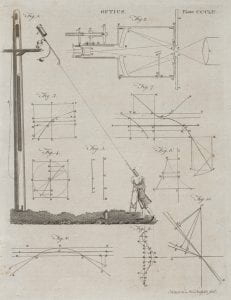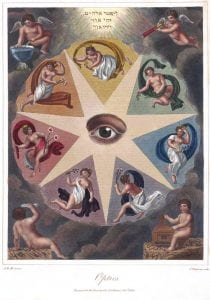Seeing science in early encyclopaedias
In honour of National Science Week from the 15th to the 23rd of August 2020, we dive into the Special Collections to look at Enlightenment era encyclopaedias and the curious prints which decorated their pages.
While encyclopaedic prototypes have existed since antiquity, the modern alphabetised compendiums of science and reason are largely the product of the late 18th century, the emergence of modernity and of course, the Enlightenment [1.]. The task of the early encyclopaedia was not easy: the Enlightenment heralded an explosion of thinking in the liberal arts and modern sciences, but also the acknowledgement that the ever-increasing wealth of human knowledge was largely inaccessible or overwhelming for lay audiences[2.]. These modern encyclopaedias sought to summarise, condense and translate knowledge into accessible digests, as can be read in the title page of Encyclopaedia Londinensis, all 24 volumes of which the University owns in the Rare Books collection:
the mechanical arts, the liberal sciences, the higher mathematics, and the several branches of elite literature, are selected from the acts, memoirs, and translations, of the most eminent literary societies in Europe, Asia, and America, forming a comprehensive view of the rise, progress, and present state, of human learning in every part of the world. [3.]
The illustrations within encyclopaedias can be seen as extensions of the knowledge presented: they are visual tools through which we see, imagine, and access learning. Two prints from the Baillieu Library Print Collection are from two different encyclopaedias and they concern optics, or the branch of physics devoted to the properties of light and its various practical manifestations. Yet, while both prints concern the same subject, they do so in two very different ways: one literally, the other allegorically.

This first print by engraver Andrew Bell is from the 13th volume of the third edition of Encyclopaedia Britannica, published in 1797. It is perhaps more akin to the image you would expect to find in an educational encyclopaedia concerned with optics, as it depicts a series of labelled diagrams of telescopes. Figure one shows a man using an early aerial telescope invented by Christiaan Huygens, described in Britannica as follows:
[Huygens placed the telescope] the top of a very long pole, having previously enclosed it in a short tube, which was made to turn in all directions, by means of a ball and socket. The axis of this tube he could command with a fine silken string […] In this method he could make use of object-glasses of the greatest magnifying power, at whatever altitude his object was [4.].

The second, colourful engraving is an eye in a star, the spokes of which divide the spectrum of colours; putti hold a prism, a telescope, a rod refracted in water, and a camera obscura; representing optics. It is from the 17th volume of Encyclopaedia Londinensis published in 1820 and is altogether more unusual.
This print comes from the long tradition in Western art of allegory, or using symbols, colours and personification to depict complex ideas. Allegory such as this is not designed to be scientific or precise in the way of diagrams or charts or indeed as the first image here, but is rather an interpretative nod to a general concept. Each aspect of this print has a narrative role: the women are the seven colours of the rainbow; primary red, yellow and blue have crowns and decorative mantles to distinguish their principal function in the creation of secondary colours. The putti hold instruments to decry the optical marvels of light, and the Hebrew script at the top is the phrase from Genesis: ‘And God said, Let there be light: and there was light.’ Each one of the 24 volumes of Londinensis has a similarly allegorical title page as an artistic interpretation of the knowledge presented inside.
While over 200 years has passed since these two compendiums of human understanding were published and the knowledge they documented has changed and progressed, we can celebrate encyclopaedias for pioneering the kind of history, reason, and scientific study that is carried forward today. While these two prints serve different functions: one as a clear and precise diagram, the other as a celebration of knowledge en masse, both are insights into we see and imagine scientific discovery.
Bianca Arthur-Hull
Special Collections Blogger
Notes
[1]. R. Yeo, ‘Preface.’ Encyclopaedic Visions: Scientific Dictionaries and Enlightenment Culture, Cambridge University Press, 2001, pp. xii.
[2.]. R. Yeo, ‘Preface.’ 2001, p. xiii.
[3.]. Encyclopaedia Londinensis, 1820, title page.
[4.] Encyclopaedia Britannica, 1797, p.270.
For open source copies of these encyclopaedias see:
Categories
Leave a Reply